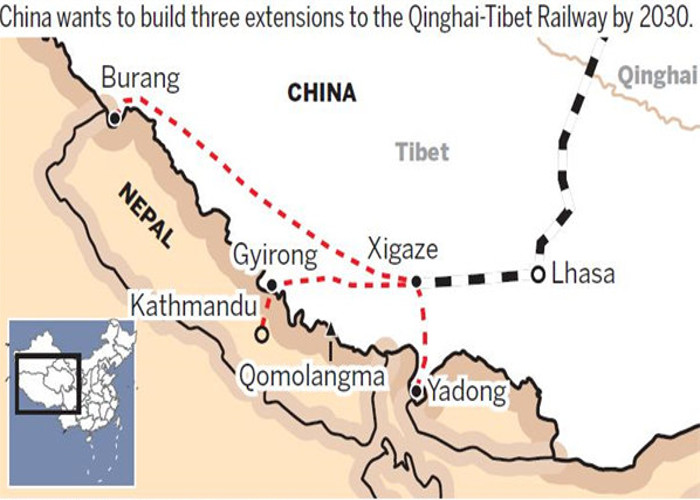The Chinese railway officials have announced that a Himalayan railway link connecting Tibet to the South Asian Subcontinent is not just a dream anymore. The officials said that it is now possible to build a railway line that would connect Tibetan capital Lhasa to Kathmandu, capital of Nepal and also to India through Sikkim.
“With more than 19,000 km of high-speed — up to 350 km per hour — railways, China has accumulated the technology and experience to build a rail link between the Tibet antonymous region and the South Asian subcontinent.” they said.
“The construction of a railway crossing the Himalayan mountains is now economically and technologically feasible,” Zong Gang, Deputy Director of the Science and Technology Department at Beijing University of Technology at a forum by China Tibetology Research Centre.
The Himalayan railway would start from Shigatse, one of largest city of Tibet, connect to Kyirong (Gyirong), a land port near border to Nepal, and extend into Nepal, although it would not be a high-speed railway, the researchers said on Thursday.
A report from a Chinese portal said that the trains run at 100 km per hour throughout the Tibetan rail system, which according to China’s railway plan for 2016 to 2020, will stretch from Shigatse to Kyirong. They also plan to connect from Shigatse to Burang, which is close to Uttarakhand border and Yadong which borders with Sikkim. The rail line extension between Kyirong and Nepal’s capital Kathmandu was agreed this year during visit of pro-China Prime Minister K P Sharma Oli in March.
Because of the change in Nepal political leaders, the Chinese counter-parts are deterred of the fact about the return of Prachanda as Nepal’s Prime Minister and they see it as a fall back to India’s influence in the country. With this shift, it also gives rise to an uncertainty of the project and a state-run media Global Times said in an article “The fixed agreements between China and the Oli government are unlikely to be changed, or it will deal a heavy blow to bilateral ties, which is too much for the new government to bear,”
The projects are big ventures by the Chinese government which they bluff of bringing development opportunities to the long isolated Himalayan nations but the real motives behind these are blurry and not transparent. The ongoing border tensions between India and China are not likely signs of possibility of such projects into reality. However, the testimony lies ahead for the new found leadership in Nepal.

